Concept by Tina Thomas. Source code written by Niek van Suchtelen and Jerry Wilhite

MOSCOW BOUND ?
POW/MIA - LCDR
JAMES KELLY PATTERSON, U.S.N.
Attack Squadron VA-35
U.S.S. Enterprise
(CVA(N)-65)
Concept by Tina Thomas. Source code written by Niek van Suchtelen and Jerry Wilhite

MOSCOW BOUND ?
POW/MIA - LCDR
JAMES KELLY PATTERSON, U.S.N.
Attack Squadron VA-35
U.S.S. Enterprise
(CVA(N)-65)
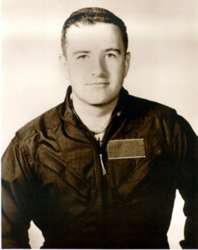
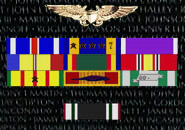
Date of Birth: 14 JUL 1940
Home City of Record: Long Beach CA
Date of Loss: 19 MAY 1967
Country of Loss: North Vietnam
Loss Coordinates: 204537N-1052539E (WH445955)
Status (in 1973): Prisoner of War/Category: 2
Aircraft: A-6A Intruder - Bureau Number 152594
![]()
It
is important for us to Bury our dead;
To pay them Tribute;
To recall their
Memories;
To lay them to Rest;
BUT CAN WE LAY TO REST A MEMORY THAT MAY STILL BE
ALIVE...?
- - Leonard Nimoy
Preface :
It was many years ago that I first obtained that silver metallic band with the name 'James K. Patterson' on it. Many others in my high school also got one, I guess in the belief that we needed to show support for those listed as Prisoners Of War and Missing In Action until they all returned. Kelly Patterson never did, but I continued to wear 'his' bracelet, long after it ceased being a 'fad' and when many just wanted to forget.
Unknowingly at first, Kelly slowly became a part of my life. I often thought about what might have happened to this man that I had never met. As the years went by, I felt the growing need to learn more about him, and was privileged to later speak with and meet many of his family members and friends. I also conducted extensive research over these years into 'the issue' and the specifics of Kelly's loss.
I have formulated an opinion based on material and circumstantial facts that he, like many other POW/MIA's, are not lost discrepancy cases to be later resolved with questionable explanations, but in all likelihood were targeted for their specialized military knowledge and skills, and became ''.
I have created this site to honor Kelly, whose silent sacrifices in the service of our country have been made for me and all Americans!!!
![]()
Please Sign The Guest Book - Your Thoughts And Comments Are Important ! ! !
A copy of each Guest Book message is automatically forwarded to Kelly's brother - George (Luck) Patterson
If you have a question about Kelly you want answered or just want to share - every message is promptly replied to...!!!


Click
On Image To
Click On Image To
Sign My Guest Book
Read My Guest Book
(Scroll To Bottom of Guest Book Page to Enter Comments)
![]()
His
Background :
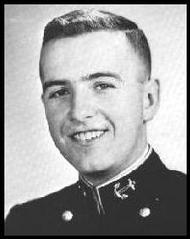
Kelly graduated from the U.S. Naval Academy in the Class of '63, and was initially assigned sea duty on the destroyer U.S.S. Renshaw - DD-499. All of his life he had demonstrated an avid interest in planes and aviation, so it was no surprise that he took private glider and fixed wing flying lessons, and ultimately received his commercial pilot's license. When his military flight physical examination revealed a minor acuity defect in one eye, he was told he would not qualify for flight school.
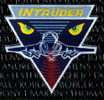 Undaunted,
he successfully applied for transfer to the Naval Aviation Officers Training
Program in 1964. Upon completing the program in 1965, he was accepted
for temporary duty in a flying status, which lead to a change in his designation
to Naval Flight Officer and his later qualification as a Bombardier-Navigator
on
the new Grumman A6-A Intruder.
Undaunted,
he successfully applied for transfer to the Naval Aviation Officers Training
Program in 1964. Upon completing the program in 1965, he was accepted
for temporary duty in a flying status, which lead to a change in his designation
to Naval Flight Officer and his later qualification as a Bombardier-Navigator
on
the new Grumman A6-A Intruder.
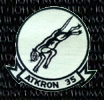
Following the completion of transition training based ashore at NAS Oceana, Virginia with Attack Squadron VA-42, Kelly was transferred to Attack Squadron VA-35, named the 'Black Panthers'. There he continued his advanced training on the A-6A, during which time his squadron commanding officer reported, "...LTJG Patterson is rapidly becoming an outstanding A-6A Bombardier/Navigator. He welcomes the competition and challenge of difficult missions, and is meticulous in planning each flight ".
![]() Click
Here To Read The Document 'Command History 1967 - Attack Squadron VA-35'
Click
Here To Read The Document 'Command History 1967 - Attack Squadron VA-35'
![]()
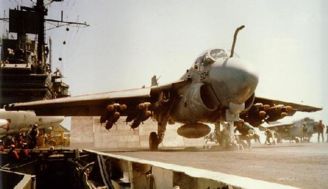 His
Plane :
His
Plane :
The Navy Grumman A-6A Intruder medium attack bombers flew their missions mostly from the decks of Navy attack carriers of the Seventh Fleet positioned off the coast of Vietnam at locations referred to as 'Yankee Station' in the north and 'Dixie Station' to the south. The Intruder was a potent strike aircraft, well suited for the humid, stormy weather and night darkness typical of Southeast Asia.
Its advanced
state-of-the-art navigation and attack system, known as DIANE (Digital
Integrated
Attack Navigation Equipment) quickly proved effective in radar guided attacks
at night or in bad weather, when no other warplane could go aloft.
The Intruder squadrons found themselves in continuous action against North
Vietnamese road and rail targets, bridges, industrial and power
plants,
airfields and ports.
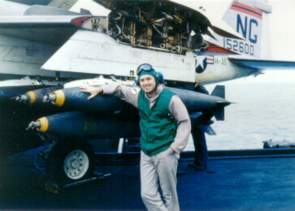
The Intruder was crewed by a pilot and a bombardier-navigator, who were seated side-by-side. The A-6A could deliver a maximum ordinance payload on its five stores locations of 15,000 lbs., second in capacity only to the B-52 (which is in stark contrast to the payload of the World War II B-17G bomber which could carry only 6,000 lbs. of ordinance and required a ten man crew). To minimize the risks of the concentrated SAM missile and anti-aircraft batteries often situated around principal targets in North Vietnam, Intruder crews used a high-speed low-altitude approach to the target, and then a steep climb to altitude before commencing the bombing run. They often flew singly or in pairs to reduce their chances of being detected and tracked by SAM sites.
The A-6 Intruder is credited with some of the most difficult single-plane strikes during the Vietnam war, including the destruction of the Hai Duong bridge between Hanoi and Haiphong. The Intruder crews were known to have, in the words of Vice Admiral William F. Bringle, Commander Seventh Fleet, 'an abundance of talent, courage and aggressive leadership'.
![]() Click
Here For
More Technical/Historical Information On The Grumman A-6 Intruder
Click
Here For
More Technical/Historical Information On The Grumman A-6 Intruder
![]()

His Aircraft Carrier and Deployment into the Vietnam Airwar :
In 1954, the U.S. Congress authorized the construction of the world's first
nuclear-powered aircraft carrier - to be the eighth U.S. warship named
Enterprise.
The ship's design replaced conventional oil-burning boilers that had powered
warships for decades with eight nuclear reactors, two for each of its four
propeller shafts. This was a daring
undertaking for never before had two nuclear reactors ever been harnessed together.
As such, when the engineers first started planning the ship’s propulsion
system, they were uncertain how it would work, or even if it would work
according to their theories.
At that time, the Enterprise; a modified Forrestal-class attack carrier, was the
largest warship of its day - afloat at 75,700 tons and 1,123 feet in length.
Materials used by the shipyard included 60,923 tons of steel; 1507 tons of
aluminum; 230 miles of pipe and tubing; and 1700 tons of one-quarter-inch
welding rods. The materials were supplied from more than 800 companies. Nine
hundred shipyard engineers and designers created the ship on paper, and the
millions of blueprints they created, laid end-to-end, would stretch 2400 miles,
or from Miami to Los Angeles. Three
years and nine months after construction began; Enterprise was ready to present
to the world as “The First, The Finest” super carrier.
![]()
![]() Here Is a Video Showing Life and Flight Operations Aboard the U.S.S.
Enterprise in 1963 (13 Min.)
Here Is a Video Showing Life and Flight Operations Aboard the U.S.S.
Enterprise in 1963 (13 Min.)
(Along with some Commentary From The Oil Industry That Helped Fund The Filming!)
![]()
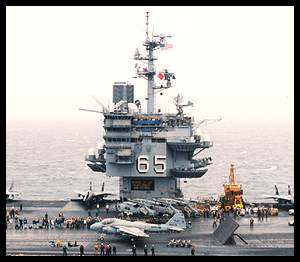 On 19 SEP 1966 - Attack Squadron
VA-35 and Kelly were assigned to Attack
Carrier Wing NINE (CVW-9) aboard the U.S.S.
Enterprise - CVA(N)65 for combat flight operations off the coast of North
Vietnam. The Enterprise began
its fourth combat deployment on 19 NOV 1966 when she again went on-the-line at 'Yankee Station'
and her squadrons resumed combat operations against targets
in North Vietnam through 06 JUL 1967.
On 19 SEP 1966 - Attack Squadron
VA-35 and Kelly were assigned to Attack
Carrier Wing NINE (CVW-9) aboard the U.S.S.
Enterprise - CVA(N)65 for combat flight operations off the coast of North
Vietnam. The Enterprise began
its fourth combat deployment on 19 NOV 1966 when she again went on-the-line at 'Yankee Station'
and her squadrons resumed combat operations against targets
in North Vietnam through 06 JUL 1967.
During this deployment new targets were rapidly becoming available as the front line of President Johnson's 'Rolling Thunder' assault rolled sporadically closer to key targets around Hanoi and Haiphong. Kelly was to fly a total of seventy-eight (78) combat missions on this combat cruise before his shoot-down. He was paired with A-6A Pilot LCDR Eugene 'Red' B. McDaniel, who following release as a POW wrote in his book 'Before Honor' (1975) of Kelly, "...We had flown together for eighteen months, almost seven hundred flight hours together. I knew his every move; he knew mine. He was twenty- six years old, round -faced, pleasant. And sensitive. Kelly would never let his bombs go if the target was at all in question due to a weak radar signal. For him, life was too precious just to let fly with destruction at anything in North Vietnam...".
One of their unique missions occurred on 26 FEB 1967, lead by the VA-35 commander; CDR Art H. Barie, in which seven A-6A's conducted the first aerial mining operations since World War II by dropping mines at the mouths of the Song Ca and Song Giang rivers to limit enemy river-borne supply traffic.
On another mission on 10 APR 1967 - Kelly was awarded the 'Distinguished Flying Cross', the citation for which reads in part, " ...LCDR (then LT) Patterson flew as leading bombardier/navigator on a pre-dawn air strike against a vital and heavily defended steel mill in the heart of North Vietnam. By navigating his aircraft at dangerously low altitude in instrument flight conditions, over mountainous terrain, he successfully evaded enemy defenses until within six miles of the target. Disregarding four surface-to-air missiles fired at his aircraft and numerous antiaircraft-artillery shells bursting around and ahead of him, he maintained steady radar tracking of the target until bomb release, ensuring an optimum bombing solution. Because of his superb navigational and radar-bombing skill, his bombs found their mark and inflicted heavy damage upon the target..." .
![]()
![]() Here Is a Brief Video That Provides a Summary of the Operational
History of the U.S.S. Enterprise CVN-65: 1965-2012 (5 Min.)
Here Is a Brief Video That Provides a Summary of the Operational
History of the U.S.S. Enterprise CVN-65: 1965-2012 (5 Min.)
![]()
![]() Here Is a Video That Provides a Good Understanding of the War in the Air over
North Vietnam (58 Min.) - Interesting U.S. and North Vietnamese Wartime Video
Footage!
Here Is a Video That Provides a Good Understanding of the War in the Air over
North Vietnam (58 Min.) - Interesting U.S. and North Vietnamese Wartime Video
Footage!
![]()
Kelly's Final Combat Mission and Shoot-Down :
Lt. James Kelly Patterson's loss event defies a quick and easy telling, but these are the facts, supported by official documents:
Kelly's final mission was on 19 MAY 1967, in which he as the
bombardier-navigator
and
his pilot,
Eugene "Red"
McDaniel
were assigned to an A6-A
"Intruder"
all-weather attack bomber (BuNo 152594) code named for the mission "Raygun
3" on an
Alpha
Strike as part of a 'Rolling Thunder' strike mission to the Van Dien Vehicle Repair Facility, located approximately five miles
south of Hanoi.
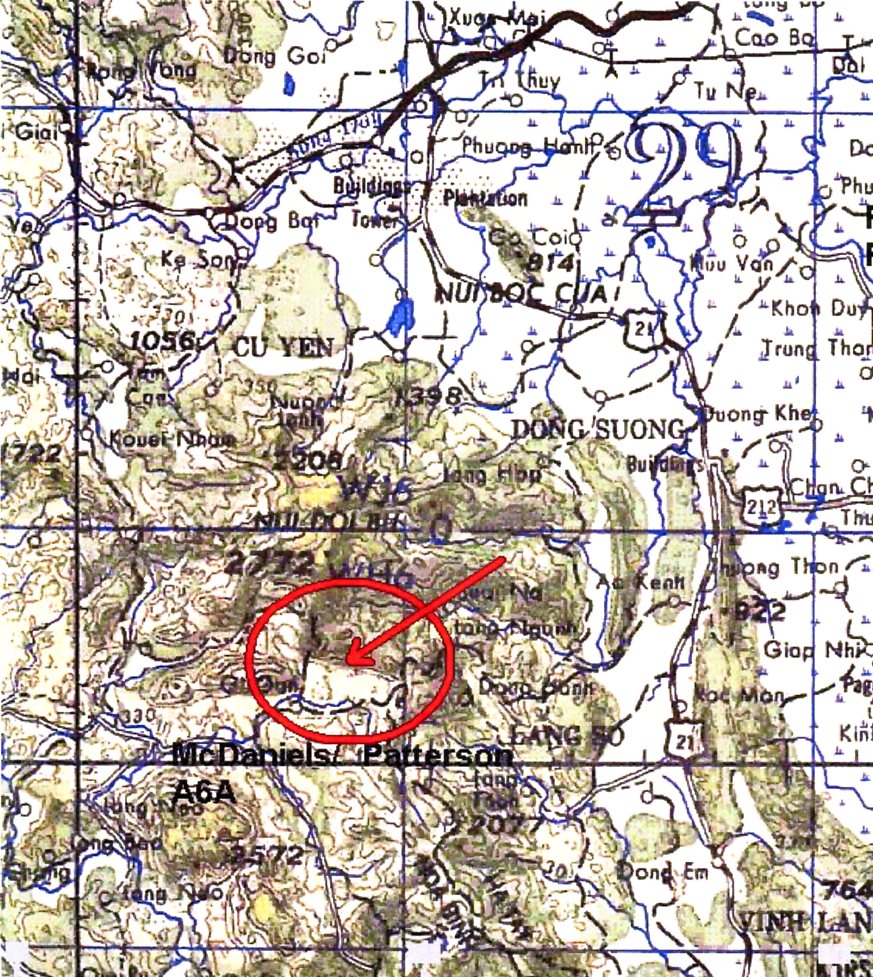
The Alpha Strike consisted of six A-6A's from Squadron VA-35, and an undetermined number of F-4 Phantom's and A-4 Skyhawk's. The target area was known to be surrounded by surface-to-air missile sites, light, medium and heavy AAA, automatic weapons and small arms, and considered heavily defended. They launched from the USS Enterprise at 1020 hours. The aircraft went in to the target area from an altitude of 15,000 feet, and sometime after 1100 and approximately twenty-five miles from the last navigational point to the target, the entire flight received a "continuous blinking red" - indicative of enemy radar attempting to track them. At 1107 hours "Raygun 1" radioed..."Missiles lift off" - having observed SAM launches likely targeting the flight, and the flight began 'jinking all the way in and back'.
Despite taking evasive maneuvering actions, one missile continued into the strike group and detonated between Kelly's plane and another A-6A. The shrapnel and pellets from the SAM missile damaged both planes, and Kelly's A-6A lost all hydraulic systems. With the resulting loss of control, the plane now leaking fuel from the damage began a twenty-degree descent toward a mountainous range. With the plane travelling a speed estimated at 250 knots and height of 2,000 feet, both Kelly and McDaniel successfully ejected, and landed in on the southeasterly slope of a small basin, while their A-6A impacted in an area commonly known as "Banana Valley" (Refer to red encircled area on map). They were downed over 'Hoa Binh' Province, North Vietnam, by this surface-to-air missile about mid-day on 'Ho Chi Minh's' Birthday, 19 May 1967, a day of scattered clouds and 10 miles visibility.
A short time later, VA-35 squadron-mates Lt. Nick Carpenter and Richard Slaasted crossed over the burning crash - and immediately located and spoke by radio to both McDaniel and Patterson on the ground (Remarks By Slaasted Are Recorded In The Guestbook Of This Web Site - Please Read).
Kelly Patterson reported on his PRC-63 Survival Radio that during ejection he had sustained a "badly broken (left) leg", and that he did not believe he would be able to move due to the injury.
'Red' McDaniel sustained fractured vertebrae in his low back when he released himself from his parachute hanging in a tree. McDaniel remained hidden awaiting rescue for 26-hours, but was ultimately captured by local village militia on 20 May before he could reach Patterson - and spent the next six years as a P.O.W. in the 'Hanoi Hilton' until his repatriation in 1973. He later stated that they were both on the ground less than a mile from the crash site.
Carpenter/Slaasted returned in their A-6A the following day (20 May) and again found Kelly Patterson without difficulty. They spoke to him on his survival handheld radio and saw him down on the ground as they passed overhead "in a U-shaped valley" (Refer to map).
The following morning (21 May) Lt. Carpenter returned in the back seat of an Air Force F-4 Phantom with the intention of effecting a rescue, and again found/saw/spoke to Patterson. They then dropped a 'Fulton Extraction Kit' - out of the plane as they passed overhead of him. The Fulton surface-to-air recovery system was used by the U.S. military and other clandestine agencies for retrieving persons on the ground utilizing aircraft in flight. It involves using a self-inflating balloon which carries an attached lift line attached to a coverall-type harness into the sky approximately 500 feet above the individual. Then a HC-130H Hercules aircraft flies into and engages the line with its V-shaped nose yoke - and the individual is pulled into the sky and reeled onboard the plane. Red flags on the lift line guide the pilot during daylight recoveries; lights on the lift line are used for night recoveries (Watch Video Below on the Fulton Extraction Kit).
Later that night, in preparation for the 'Fulton Extraction' two other F-4 Phantom's again readily found Kelly Patterson, who reported by radio that it appeared that he was now surrounded by the North Vietnamese, that the Fulton Extraction gear had been captured by them and taken away before he could crawl to it, and that he had again moved back up a hill for safety to await rescue.
On the morning of 22 MAY 1967, U.S. planes again returned to the area, but were unable to regain radio contact or visually locate Patterson in the shoot-down area, and further efforts to rescue him were canceled.
Lt. Nick Carpenter was shot down during his second WestPac deployment while flying a night mission on 24 June 1968 - targeting the Kim Ma water interdiction point near Vinh, North Vietnam. Other planes in the area witnessed 'AAA' fire in the area and then a "fireball" which was thought to be his A-6A exploding. Carpenter did not survive the war, and his remains were only returned by the North Vietnamese to the U.S. on 13 September 1990, and identified on 27 March of the following year.
In an after-war interview, Richard Slaasted told Kelly's brother that the area around Patterson contained villages and a truck-worthy road. The correct coordinates of Patterson's last known location and the crash site have not survived in the official records, but (established from U.S. eyewitness reports) we know that he was within one mile of McDaniel - or even closer to the crash site (Carpenter), in a U-shaped valley (Carpenter), and in the vicinity of villages and a truck-worthy road (Slaasted).
![]() Click
Here To Read The Communications Document Reviewing 'Combat SAR Activities' on
May 21, 1967
Click
Here To Read The Communications Document Reviewing 'Combat SAR Activities' on
May 21, 1967
![]()
![]() Here Is a Short Video Which Explains the 'Fulton Surface-to-Air Recovery System'
(3 Min.)
Here Is a Short Video Which Explains the 'Fulton Surface-to-Air Recovery System'
(3 Min.)
(Rescue Equipment Dropped to Kelly Patterson in North Vietnam)
There is ample evidence to indicate Patterson was captured :
During the nearly
six years he was a prisoner of war, Eugene 'Red' McDaniel never again saw his bombardier-navigator.
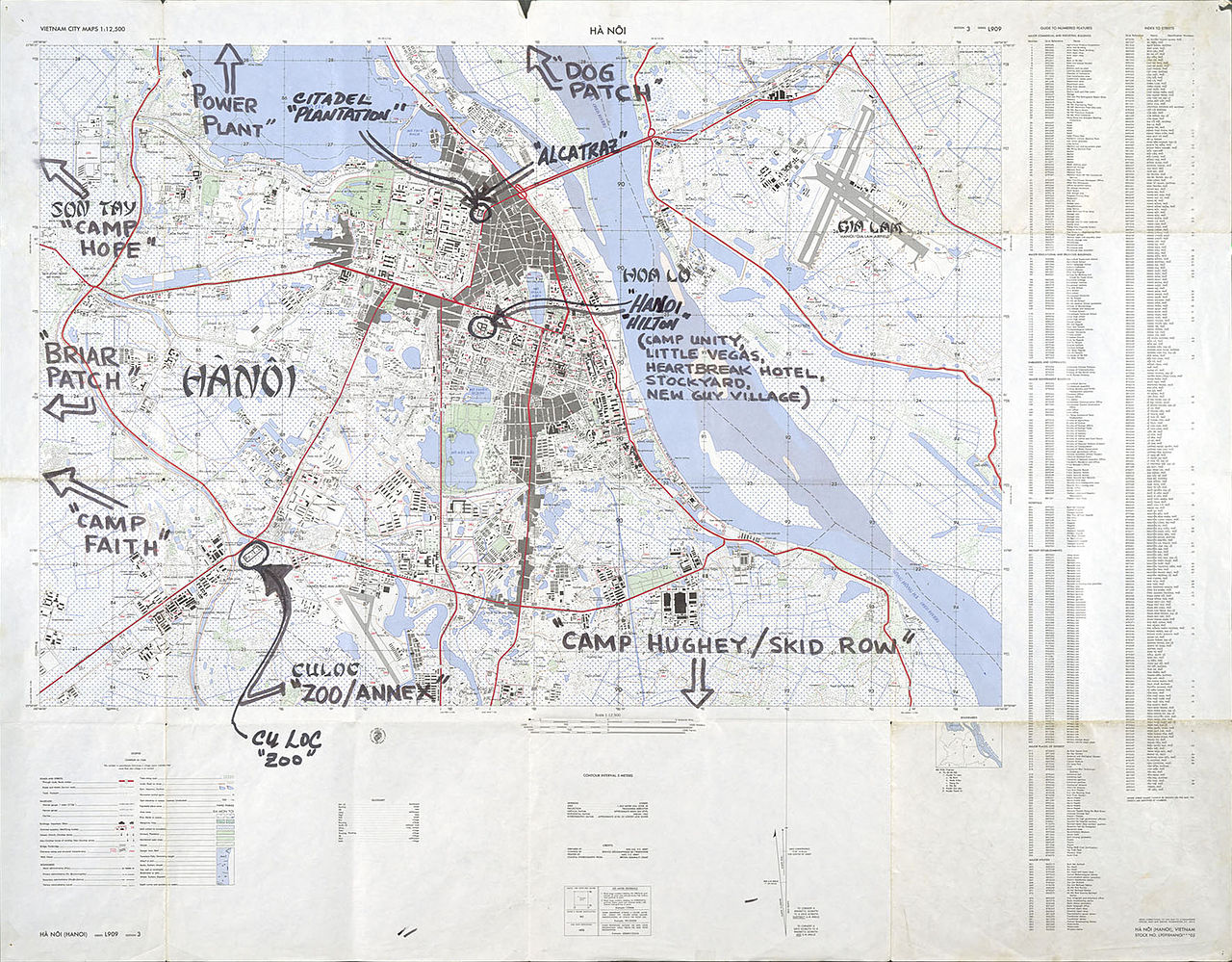
But he continually asked about Kelly Patterson within the prison camp, and was given conflicting stories. In Late 1967, he was told by an unidentified NVN prison guard that Lt. Patterson's leg had "healed well" and he had recovered from his injuries.
![]() Click
Here To Read Article "Where Is James Kelly Patterson?" - Written by
Eugene 'Red'
McDaniel - Published by the Shipmate Magazine
July-August 1996 (Reproduction Rights Courtesy of USNA Alumni Association and
Foundation)
Click
Here To Read Article "Where Is James Kelly Patterson?" - Written by
Eugene 'Red'
McDaniel - Published by the Shipmate Magazine
July-August 1996 (Reproduction Rights Courtesy of USNA Alumni Association and
Foundation)
Another repatriated POW, Air Force Major Dewey Smith shot down on June 02, 1967, said that while being interrogated at the Hoa Lo (Hanoi Hilton) Prison in the Fall of 1967 - he saw an interrogation questionnaire with Kelly Patterson's name at it's head.
Air Force Lt. Ronald Mastin became a POW after being shot down on January 16, 1967, and reported that during his captivity in Hanoi - he saw what he believed to be a photo of Kelly Patterson's ID card in a Vietnamese newspaper during the same year.
One case which supports the theory that only a portion of the total POWs held by the North Vietnamese were released as part of the Paris peace settlement in February-March 1973 - involves a civilian named Bobby Jo Keesee. Keesee was a Korean War veteran reportedly turned criminal, who hijacked an aircraft from Thailand and forced it to land on a North Vietnamese beach on September 18, 1970. He was captured and afterwards held in various military prison facilities in NVN until his release on March 14, 1973. His presence in the NVN prison camp system was unknown by other military prisoners for the term of his imprisonment, until his existence was discovered by accident only days before the general prisoner release in the spring of 1973 by an American POW. Keesee had been held in a separate section of the Hoa Lo Prison away from all other Americans, and had purposefully not been listed as a prisoner by the North Vietnamese. He may yet be imprisoned there it not for a unified effort on the part of other POWs to see that he was released with them.
Upon his return to the U.S., Keesee told Kelly's brother during a face-to-face meeting in 1973 that while he was in captivity he saw Kelly Patterson's name scratched on a cell wall in a remote North Vietnamese prison near the Chinese border.
![]()
![]() Here Is a 1992 Interview with Kelly's Pilot -
Captain Eugene (Red) McDaniel - Discussion on How Thousands of US POWs Were
Left
Behind, and Still May Be Alive Today (23 Min.)
Here Is a 1992 Interview with Kelly's Pilot -
Captain Eugene (Red) McDaniel - Discussion on How Thousands of US POWs Were
Left
Behind, and Still May Be Alive Today (23 Min.)
![]()
![]() Here Is a Video - "Missing, Presumed Dead:
The Search for America's POWS" - Korean War (1:04 Hr.)
Here Is a Video - "Missing, Presumed Dead:
The Search for America's POWS" - Korean War (1:04 Hr.)
"Missing, Presumed Dead: The Search For America's POWs"
![]()
![]() Here Is a Video - "POWs: The Documented Cases of
POWs Left Behind" (43 Min.)
Here Is a Video - "POWs: The Documented Cases of
POWs Left Behind" (43 Min.)
![]()
![]() Here Is a Video - "We Can Keep You Forever" (1:13 Hr.)
Here Is a Video - "We Can Keep You Forever" (1:13 Hr.)
"We Can Keep You Forever"
![]()
![]() Click Here To Review Evidence Of A Likely
Secret Underground Prison Facility Built In Hanoi 1970
Click Here To Review Evidence Of A Likely
Secret Underground Prison Facility Built In Hanoi 1970
The Vietnamese Explanation(s) in 1990 :
Twenty-three years after Patterson's loss, in December 1990, the Vietnamese brought before U.S. military investigators four "witnesses." This was their testimony, supported, in part only, by Vietnamese reports of dubious authenticity:
The militiamen involved in the search for "Raygun 503's" aircrew mobilized from Thuong Tien village in Kim Boi district. After searching in very rough terrain (described in various Vietnamese reports as a heavily forested, steeply sloping tall mountain) they captured the Fulton gear.
Nearby they found Kelly Patterson, who allegedly stood straight up with a pistol in his hand when confronted (remember his 3-day old badly broken left leg). He was then shot in the chest by a militiaman with a rifle mortally wounding him, and buried on the spot in a shallow grave. This was in disobedience to a North Vietnamese and Viet Cong policies in place during the War. Strict procedures distributed through Vietnam outlined the proper handling of US remains that included removing identifying data and individual equipment items, personal items, and pocket litter - burial of the remains for later collection and warehousing - and sending the identification and location of the grave site to Hanoi (See below for further reading in 'Concluding Comments' about this policy of recovery and repatriation of remains).
Some time later his body completely disappeared because (according to "witness" testimony and previous reports) it was either - - - 1) bombed by U.S. planes, or 2) eaten by wild animals, or 3) washed away by a nearby stream.
The location of this "grave site" was given as (in UTM coordinates) WH43718409. This point is on a ridgeline about midway down it's three mile length running south from the top of Nui Doi Thoi, the highest mountain in the area.
We do know the Vietnamese made contact with Patterson because they took from him his Military I.D. Card and Geneva Conventions card and returned them to the U.S. in 1985 (Note: I have personally examined the Military I.D. Card - which bears Vietnamese characters written on the plastic lamination). Later, to lend credence to one of their reports, they attached a photocopy of the Geneva Conventions card. The card they copied, however, was phony - not matching the real card now in his brother's custody!
The actual Vietnamese-claimed "grave site" was pointed out by the "witnesses" and thoroughly investigated in May 1992 by a U.S. team of experts borne on helicopters (the site is inaccessible by truck).
Nothing to indicate a body had ever been there was found. No trace or evidence of remains, not a button, a shred of cloth, a tooth, a zipper, was located. In fact the soil strata itself was found to be undisturbed.
In spite of the absence of remains, in spite of numerous U.S.-noted contradictions and inconsistencies between "witnesses," between "witnesses" and previous Vietnamese reports, and between "witnesses" and the established facts, and without first showing the established facts to be in error, U.S. investigators threw out those established facts in favor of the un-corroborated "witness" testimony!
They accepted the "grave site" as Patterson's last known location, even though it is on a ridge on the steep south slope of 3,930 foot Nui Doi Thoi mountain, not a valley or village or truck road within several kilometers.
Despite the evidence of his survival and without any proof to the contrary whatsoever, Patterson's alleged death was accepted as fact!
Since the Vietnamese and the U.S. now agreed as to his fate, his case, once a "compelling discrepancy", was now considered "".
Kelly's brother, George (Luck) Patterson would later state in February 1994: "I believe (Kelly) Patterson survived his capture, and the Vietnamese story is a fabrication possibly to cover the absence of a body for a living prisoner last seen being led away to Kazakhstan."
![]()
Personal Biography and
Follow-Up Investigation By Kelly's Brother - George 'Luck' Patterson (February, 1999)
:
As soon as James Kelly Patterson was old enough
to gaze skyward, airplanes and flying became his lifelong obsession. A
talented artist, one of his earliest grade school paintings shows a barefoot,
straw-hatted Huck Finn type
walking along a country path, stringer of fish a-dragging, cane pole a-toting, and over his head, a jet airplane.
His model fighters and
bombers hung from our bedroom ceiling, frozen in combat.
On
weekends I was his captive assistant at the Rose Bowl parking lot where he flew
his powered models. They all eventually crashed or flew out of
sight, giving him an excuse to start building new ones. It's not
surprising that the lowest point in his life came when he learned that Naval
Academy study had ruined his eyes for pilot training. But he shook
it off and, determined to be airborne, became, according to his commanding
officers, a stand-out, inspired combat bombardier- navigator, one of the best in
the business.
Maybe we were naive, but we thought the Vietnam
issue was pretty simple: the communist North was poised to enslave the free
South, our ally. America was right to intervene. And growing up
siblings in a Navy family, entranced by every episode of "Victory at
Sea", there was no question about it -- Kelly and I were duty-bound to go,
and would go willingly. So he shipped out for Southeast Asia in
December of 1966 as a B-N in a carrier-borne A-6 squadron, and, O'Sullivan Act
notwithstanding, I followed in January.
After dozens of truly harrowing missions over the
north, and several citations for bravery and outstanding performance, Kelly
earned a much needed R&R in April. But he left Yankee Station, not for
Bangkok or Honolulu or Brisbane, but for DaNang, South Vietnam. There he hopped a Marine convoy and found his way to my outfit in the bush.
Not unheard of, this was at least out of the ordinary. The Navy had
invested a small fortune in his training, making him an expert in the use of the
state- of-the-art electronics that was neutralizing Hanoi's air
defenses. How he got approval for this trip, I don't
know. Maybe he told his commanding officer he just wanted to see his
kid brother in DaNang.
He had always been a protective big brother, and
here he was again, checking on my welfare, easing our folks' concerns. He found
me as I was preparing my Marine rifle platoon for a three day patrol, and not to
be denied a visit, asked to go along. So I issued him a helmet, flak
jacket, and rifle,
and at O-dark-thirty stepped out of our perimeter into Indian country, Kelly in
tow to share my muddy war in the paddies.
Our time together was cut short when my platoon was choppered out to pursue an
NVA force which had hit the Marines in the foothills inland, but the two days we
had together were very special. When we could, we talked about home
and family, and of course the war. Kelly was living his dream,
flying a carrier based Navy warplane in combat. Saving the South
Vietnamese from the horrors of Communism was reason enough for
fighting. He had no animosity toward the common people of the north,
and took extreme care (to his own hazard, I learned later) to avoid civilian
casualties on his bombing runs. He didn't even mind that the anti-war
groups at home were sending medicine to North Vietnam. Maybe some of
it found its way to the villagers, he reasoned, and maybe they would return the
favor some day.
I treasure the memory of these, as it turned out
our final, hours together. Kelly's conduct as a Naval officer,
as a warrior, and as a man, and most especially as a brother, was extraordinary.
When I last saw him,
through the rotor dust of a rising "Sea Knight" helicopter, he was
riding atop an am-trac headed back to his war. On May 19, 1967, Kelly was shot down
over North Vietnam. With his pilot, Eugene "Red" McDaniel,
he ejected, and with a broken leg evaded capture for three days.
Then he disappeared...
![]()
![]() Here Is a 2024 Interview with Kelly's Brother -
George (Luck) Patterson - As He Discusses the Background Surrounding His
Brother's Unresolved Loss (1:22 Min.)
Here Is a 2024 Interview with Kelly's Brother -
George (Luck) Patterson - As He Discusses the Background Surrounding His
Brother's Unresolved Loss (1:22 Min.)
![]()
The North Vietnamese remained silent for 18 years, ignoring all inquiries.
Then, in 1985, they suddenly claimed that their militia had found Kelly in the jungle, shot him dead when he resisted in a short gun battle, and buried him
on the spot. Their several written reports of the incident
conflicted with the accounts finally given to US investigators by two "eye
witnesses" a few years later. And when the investigators dug up
the spot where Kelly was supposedly buried, they found only undisturbed soil
strata. No bones, no teeth, not a zipper, button, or buckle. Nevertheless, the US concluded that
Kelly had died, "KIA, body not recovered".
Actually, there was persuasive evidence that he
had survived his capture. McDaniel, a prisoner, was told by
his guard that Kelly had recovered from his injury and was well. Another prisoner saw his name headlining an
interrogation questionnaire. This and other evidence could not be
corroborated or verified, any more than his death. None of it could be proven
erroneous either, any more than his death. It was persuasive, but
inconclusive.
Then this :
Shortly after the fall of the U.S.S.R., investigative reporter Yuri Pankov, in the respected Moscow Newspaper 'Kommersant', wrote in an article on 04 November 1991 that a U.S. "second pilot" shot down over North Vietnam on 19 May 1967 was taken overland through a "window" in the China-Soviet border to Saryshagansk on Lake Balkash - in the then Soviet Socialist Republic of Kazakhstan during the Fall of 1967. The author even suggested that the American aviator was still working in the area (though he later recanted this).
A February issue further stated he was transferred soon to nearby Priozersk. These were in a closed Russian military region dedicated to missile research and testing.
Kelly Patterson's is the ONLY unresolved M.I.A. case meeting Pankov's criteria. Note: He (Patterson) was an expert in the use of his aircraft's state-of-the-art electronics being used to defeat Vietnam's Russian-made missile defense system - Saryshagansk, Kazakhstan was the site of a modern Soviet military missile research facility involved in the development of more sophisticated and effective technology to circumvent the American countermeasures.
![]() Click Here To View the Moscow Business
Newspaper 'Kommersant' Article as Published in English (1991)
Click Here To View the Moscow Business
Newspaper 'Kommersant' Article as Published in English (1991)
As shocking as this was, it made some sense to
me. The A-6 "Intruder" electronic systems were
cutting-edge at the time, routinely defeating the Russian air defenses deployed
around Hanoi (and incidentally, around Moscow). Kelly was highly
skilled in the use of these systems. If he could be made to tell
when he did what, and why, he might be of some use in developing
countermeasures.
In the months following this revelation, a concerted effort was made to find the
source of the information, one Russian Army Major Vladeslav Timaschov. Timaschov, we were told, was dead, no proof offered.
In 1994, George J. Veith (authored "Code
Name Bright Light") reasoned that if Kelly had been taken to Priozersk,
just possibly a scientist still living in Kazakhstan might remember
him. At his suggestion, I wrote letters with Kelly's picture,
description, and possible circumstances then and now, to 62 Kazakhstan physics
researchers.
In Alma Ata, the capital of now independent
Kazakhstan, Professor Evgeny Kolomeets, known internationally for his work in
cosmic ray physics, took a special interest in my letter. It seems he had been assisted by
total strangers in locating his missing father's grave following World War 11,
so at his own expense he published Kelly's picture and story in two newspapers.
Soon
afterward, he was telephoned by a woman who claimed she met Kelly when she was
13 years old! She said that her stepbrother, an army officer
assigned to Priozersk, and some of his officer friends came to her house one
night accompanied by this American. She talked with this man, who
told her he was confined to the military base and unable to move about
freely. As a memento of their meeting, this American gave her a
doll, which she still had to this day. She never again saw him, but
was curtly told later by her stepbrother, angry that she had asked, to forget
about the American, that he
had died in an auto accident in Moscow. She said she was 100%
certain the picture in the paper was the American she had met, and she would remember his face as long as she lived.
She asked for nothing in
return for her story, but she refused to give her name, fearing the consequences
to her and her 12 year old son.
Encouraged by this contact, Kolomeets began
asking colleagues if they knew of an American at Priozersk in the late
sixties. One colleague told him not
one, but several Americans had been there. An active duty colonel
said there had been two, possibly three American "consultants" in
Priozersk. A young man who had recently worked in Priozersk was interviewing for a job with
the professor when he said that it was general knowledge that Americans had been
present there in the 1970s. Again, these and others insisted on
anonymity.
Kolomeets believed that if I came to Alma Ata and made personal appeals for
information through the various news media, people still wary of Soviet era
security bureaucracies might be encouraged to approach me. So, armed
with a home-stay visa based on the professor's invitation and his promise to the
state to "supervise" my activities, the blessing of JCSD (Joint
Commission Support Directorate, the investigative arm of our side of the
US-Russian
Joint Commission on POW/MIA's), and funding by Kelly's brothers of the US Naval
Academy class of '63 and elsewhere, I flew to Kazakhstan in October of
1997.
For over a week, and almost always accompanied by
the professor, I was interviewed by a number of radio, television, and newspaper
correspondents. As with any media coverage, the resulting stories were not always accurate in
every detail, but the basic truths were communicated: an American is in
Alma Ata looking for his American brother, James Kelly Patterson, shot down in
Vietnam 30 years ago and thought to have been brought to Priozersk.
Patterson was unmistakably identified as an American, which made the story
unique and readable.
'Radio Liberty' broadcast the story throughout
the old Soviet Union. Soon afterward, a woman living in Lugansk, in the
Ukraine, phoned the correspondent and excitedly told him that she knew
Patterson! In their taped conversation, she said that she worked in
Priozersk in the 1960s and 1970s, and Patterson was there in another
directorate. She was unsure of his first name, but thought it could
have been James. She was also unsure of the year, but believed it
was around the mid 1960s (later, she revised that to 1969). She said
he died a stabbing victim. Significantly, she never raised an
eyebrow at Patterson being an American. Midway through their
conversation, the correspondent asked her "How did this American end up
there?" She replied, "I couldn't tell you
that. We did not know from where ....(tape garbled)."
This woman was unique among those claiming Kelly
or other Americans had been at Priozersk: she identified herself openly, gave
her address, and didn't object to further inquiry. She named others
who knew Patterson. We were pretty excited, Professor Kolomeets and
I. Even JCSD seemed to sense a possible breakthrough.
At the airport in Moscow on my return trip from
Kazakhstan, I met the JCSD investigators in route to interview the Lugansk
woman. One week after the
radio broadcast, she now told them that Patterson was a Soviet officer, and she
named a friend who could corroborate her story. The friend told
the investigators that he and Patterson had been cadets at a radio-technical academy
in Kiev, that Patterson had graduated in 1963 and was then transferred to
Priozersk.
I was, of course, disappointed at this news.
I
was told that although the name Patterson was not common in the old Soviet
Union, it did occur. But I couldn't shake a nagging skepticism about
the Lugansk woman's story to our investigators. Her telephone
conversation with the radio correspondent had seemed spontaneous and candid,
totally lacking guile. She never once expressed concern that
Patterson was American, a fact made clear in the broadcast and in their
conversation. I speculated that after this
phone conversation, someone told her: "You're opening Pandora's box and
making a
big mistake. If I were you, I'd tell them this story: ...."
Following its interview with her, JCSD asked that
the archives of the radio-technical academy in Kiev be checked to confirm that a
Patterson, or Paterson, or Peterson had been a cadet there 1960 through
1964. They also asked the Russian side of the Joint Commission to
check its military archives for a Soviet officer named Patterson assigned to
Priozersk in the 1960s. The replies received in the months that
followed: From the Ukraine Ministry of Defense -- no Patterson, Paterson, or
Peterson was a cadet at the radio-technical academy. From the Russian
side of the Joint Commission--no Soviet officer named Patterson was assigned to
Priozersk.
But on January 19, 1999, the Russians about-faced
and told JCSD that one Pavel Semenovich Peterson (pronounced by the Russians
"Paterson" with a
long "a" as in patriot) had indeed been assigned to Priozersk, where
he died on June 6, 1965, and is now buried in the Ukraine. The
information they
gave was sufficient for follow-up inquiries by the US.
For JCSD, this investigation was now
complete. Nevertheless, while conducting other inquiries in the
Ukraine, they asked for a re-examination of the archives of the radiotechnical
academy in Kiev. This time the academy found the name Pavel S.
Peterson, a cadet there from 1955 to 1959.
I would like to say this is closure for me
also. It almost is. I'm not sure what to make of the date
discrepancy between the academy's records and the memory of one of its cadets.
I'm trying to make contact with
another witness in Priozersk, and I'd really like to talk to Pavel Semenovich Peterson's relatives in the Ukraine.
Maybe one day some of Professor
Kolomeets's sources will brave going public, or we'll find Vladeslav Timaschov very much alive and willing to tell all.
Anything can happen, and if
anything does, I'll update Kelly's story.
![]()
UPDATE: The entire 'Radio Liberty' broadcast program was tape recorded including the woman's call. A week later when the lady was questioned for more details about Kelly Patterson, and she quickly changed her story claiming she had been mistaken, that the man she knew was a Soviet Officer who was a graduate of an advanced radio/engineering academy in Kiev in 1963. The surname 'Patterson' is listed in a book of common and uncommon Soviet names. In checking further, the investigators found no record of a Patterson, or a variation of that name, attending or graduating that academy from 1960 to 1964. Likewise, there is no record of a Patterson having been a Soviet Officer assigned to Priozersk in the 1960s. Kelly's brother did not know why she changed her story, but he firmly believes someone coerced her into doing so. Who that someone is and why it was done could not be established.
![]()


A SOVIET CONNECTION TO KELLY'S LOSS ???
There
has been much documentation and analysis of historical records in recent
years to validate certain
Communist motives and patterns involving missing American and allied serviceman.
This
can be traced back to the prisoners-of-war held by the Soviet Bolshevik's
in World War I, liberated but unrepatriated allied prisoners in Germany
following World War II, prisoners-of-war not exchanged during Operation
BIG SWITCH by North Korea following the Korean Conflict, classified personnel
losses over Communist territories during the Cold War, and
of course those missing from the Vietnam Conflict. Throughout
this historical timeline, a common theme is observed. It is
outlined in the United States Senate Report issued on May 23, 1991, 'An
Examination of U.S. Policy Toward POW/MIAs' which states in
part: "...In
each case, the same dismaying scenario appears: On the Communist
side, the regimes
denied holding U.S. prisoners, contrary to many credible reports, while
in fact they
were holding the U.S. POW/MIAs as slave laborers and as reserve bargaining
chips to get diplomatic recognition and financial assistance. On the
U.S. side, our government downplayed or denied the reports of POW/MIAs, and
failed to take adequate steps to prove
or disprove the reports, while elements in our government pursued policies
intended to
make diplomatic recognition and financial support of the revolutionary
regimes possible..."
In November 1992,
the U.S. Senate Committee on POW/MIA Affairs heard testimony from government
officials and former members of the U.S. Armed Forces on POW/MIA cases from
the Korean War, and the Soviet Union’s involvement in POW/MIA cases from the
Vietnam War.
Witnesses also testified on investigations conducted in the
former Soviet Union to determine whether American POW’s may still be held in
prisons against their will.
![]() Click
Here To Read The Full U.S. House of Representatives Congressional Record -
'Another Look at our POW/MIAs'
in Vietnam: What Was Moscow's Role (October, 1991)
Click
Here To Read The Full U.S. House of Representatives Congressional Record -
'Another Look at our POW/MIAs'
in Vietnam: What Was Moscow's Role (October, 1991)
![]()
Soviet Involvement with Vietnam POW/MIA's
Another
report released by the Pentagon in November, 1993, entitled 'The Transfer
of U.S. Korean
War POWs to the Soviet Union', concluded in
part:
"...The
Soviets transferred several
hundred U.S. Korean War POWs to the USSR and did not repatriate them. This
transfer was mainly politically motivated with the intent of holding them
as political hostages,
subjects for intelligence exploitation, and skilled labor within the camp
system..."
![]() Here Is a Video
from the U.S. Senate Hearings on November 11, 1992 (Morning Session) that was broadcast live on C-Span (4:06 Hrs/Min.)
Here Is a Video
from the U.S. Senate Hearings on November 11, 1992 (Morning Session) that was broadcast live on C-Span (4:06 Hrs/Min.)
![]() Here
Is a Video from the U.S. Senate Hearings on November 11, 1992 (Afternoon
Session) that was broadcast live
on C-Span (4:13 Hrs/Min.)
Here
Is a Video from the U.S. Senate Hearings on November 11, 1992 (Afternoon
Session) that was broadcast live
on C-Span (4:13 Hrs/Min.)
![]() Click
Here To Read The Full DPMO Report - 'The Transfer Of U.S. Korean War POWs to the USSR'
(August 1993)
Click
Here To Read The Full DPMO Report - 'The Transfer Of U.S. Korean War POWs to the USSR'
(August 1993) ![]()
![]() Click
Here To Read The Article - 'Chicoms Finally Confess About Korean War POW/MIAs'
Click
Here To Read The Article - 'Chicoms Finally Confess About Korean War POW/MIAs' ![]()
![]() Click Here To Read The
Article - "On The Trail of the MIAs" - Recollections by Former NSA
Analysts Jerry Mooney and Terry Minarcin
(October 27, 1991)
Click Here To Read The
Article - "On The Trail of the MIAs" - Recollections by Former NSA
Analysts Jerry Mooney and Terry Minarcin
(October 27, 1991)![]()
![]() Click
Here To Read The Newspaper Article - 'Eisenhower Knew Of Pows In Soviet Union,
Officer Says A Government Analyst Disputed The Assertion That About 1,200
Americans Were Held In The 1950s' (November 11, 1992)
Click
Here To Read The Newspaper Article - 'Eisenhower Knew Of Pows In Soviet Union,
Officer Says A Government Analyst Disputed The Assertion That About 1,200
Americans Were Held In The 1950s' (November 11, 1992) ![]()
![]() Click
Here To Read The Full Article - The American Spectator 'The MIA Coverup'
(February 1994)
Click
Here To Read The Full Article - The American Spectator 'The MIA Coverup'
(February 1994)![]()
![]() Click
Here To Read The Full Article - The New American 'America's POW Secrets Exposed'
(October 28, 1996)
Click
Here To Read The Full Article - The New American 'America's POW Secrets Exposed'
(October 28, 1996)
![]()
![]() Click
Here To Read A Book Report - "Forgotten War, Forgotten Soliders: How US POWs
Were Surrendered to North Korea, China and Russia"
(July 26, 2013)
Click
Here To Read A Book Report - "Forgotten War, Forgotten Soliders: How US POWs
Were Surrendered to North Korea, China and Russia"
(July 26, 2013)
![]()
![]()
![]() Click Here To Read The
DOD-CIA Joint Report #1999-5974-IG - 'A Review of the 1998 National Intelligence
Estimate on POW/MIA Issues...' (February 2000 - De-Classified Complete Report)
Click Here To Read The
DOD-CIA Joint Report #1999-5974-IG - 'A Review of the 1998 National Intelligence
Estimate on POW/MIA Issues...' (February 2000 - De-Classified Complete Report)
![]()
![]() Click Here To Read The
National Intelligence Council-CIA Report #NIE 98-03 - 'Vietnamese Intentions,
Capabilities, and Performance Concerning the POW/MIA Issue' (April 1998 -
De-Classified)
Click Here To Read The
National Intelligence Council-CIA Report #NIE 98-03 - 'Vietnamese Intentions,
Capabilities, and Performance Concerning the POW/MIA Issue' (April 1998 -
De-Classified)
![]()
In February, 1993, a scholar from the Harvard University Russian Research Center discovered an important document in the archives of the Central Committee, Communist Party Soviet Union, while doing research in Moscow./b>
The document, later referred to as 'Quang or 1205', was a Soviet GRU (General Staff Military Intelligence Directorate) translation into Russian of a presentation to the North Vietnamese (DRV--Democratic Republic of Vietnam) Politburo by a Deputy Chief of the North Vietnamese General Staff, General Tran Van Quang. The presentation concerned the status and number of American POWs in North Vietnam as of September 15, 1972, which was five months before Operation Homecoming began.
The most important point in General Tran Van Quang's presentation was the statement that 1205 American POWs were being held in North Vietnam at that time, which means that after the 591 POWs were released from Hanoi during Operation Homecoming, there were at least 614 American POWs left behind !!!
![]() Click Here To Read The Full Contents of the 'Quang - 1205 Document'
Click Here To Read The Full Contents of the 'Quang - 1205 Document'
![]() Click Here To Read About Authentication and Discussion of the 'Quang - 1205 Document'
Click Here To Read About Authentication and Discussion of the 'Quang - 1205 Document'
![]() Click Here To Read The Full Contents of the 'Spy
Papers Back MIA Cover-Up Accounts'
Click Here To Read The Full Contents of the 'Spy
Papers Back MIA Cover-Up Accounts'
![]() Click Here To Read The '(Former NSA
Analyst Jerry) Mooney Documents'
Click Here To Read The '(Former NSA
Analyst Jerry) Mooney Documents'
![]() Click
Here To Read The Historical Assessment Article - 'POW's Left Behind In Indochina'
Click
Here To Read The Historical Assessment Article - 'POW's Left Behind In Indochina'
![]() Click
Here To Read The Rand Corporation Research Paper on "Prisoners of War in
Indochina" (Janaury 1969) - De-Classified from Secret
Status
Click
Here To Read The Rand Corporation Research Paper on "Prisoners of War in
Indochina" (Janaury 1969) - De-Classified from Secret
Status
![]() Click
Here To Read The Article - 'McCain and the POW Coverup'
Click
Here To Read The Article - 'McCain and the POW Coverup'
![]()
![]() Click
Here To Read The Article - 'When John Kerry's Courage Went M.I.A.' (February
17, 2004)
Click
Here To Read The Article - 'When John Kerry's Courage Went M.I.A.' (February
17, 2004)
The 'National Alliance of Families' reports that "...In the early part of 1992, Senators from the Select Committee on POW/MIA Affairs traveled to Russia. During their visit they requested the Russians conduct a comprehensive search of all records to possibly locate the names of POW who the Soviets may have had contact with, during the Vietnam War. From a reliable source, we learned the Russians responded in May of 1992, with a list of 41 names. However, their response would remain hidden, for another 16 months. In June 1992, Boris Yeltsin visited the United States. During the flight, to the United States, Mr. Yeltsin was interviewed by NBC's Dateline. During his interview, Mr. Yeltsin spoke of American POWs taken into the Soviet Union. Not only did Mr. Yeltsin speak of Americans taken to the former Soviet Union, he offered the possibility that some may still be alive..."
It has been suggested that Kelly Patterson's name appears to be included in that list of those who were sentenced for various offenses during the period of 1922 through 1968 under the heading of "Criminal Offenses".
![]() Click
Here To Read The Information Relating to 'The Russia List'
Click
Here To Read The Information Relating to 'The Russia List'
(Did the Russians Provide a List of 41 Americans Questioned by the Soviets or Taken to the Former Soviet Union?)
![]() Click
Here To Read The Article 'Archangel, 1918 to Hanoi, 1972'
Click
Here To Read The Article 'Archangel, 1918 to Hanoi, 1972'
American military investigators have uncovered evidence of the Soviet presence during the Vietnam War. Unclassified Soviet archives reveal the establishment of specialized intelligence units who were tasked to acquire and ship to the U.S.S.R. our latest military technology.
Though our Government would appear to have no success in learning the "classified" components of these Soviet programs, it would only seem logical to assume they would also call for the collection and interrogation of U.S. military personnel trained in the use of such high-tech weapons systems. In 1967, Kelly Patterson represented one of those very highly trained men, and his classified knowledge of the computerized, then state-of-the-art A6-A bomber would be a valuable prize. This would be the very technology that the United States would have used against the Soviet Union had hostilities initiated.
The 'U.S. - Russia Joint Commission on POW/MIAs' reports:
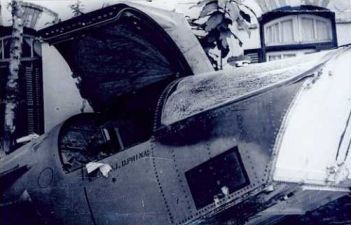
"...During the war, a Soviet trophy group, or "spetzgruppa," composed of GRU officers, was deployed to Vietnam to acquire captured American combat equipment and arrange for shipment to the Soviet Union for exploitation. Although the U.S. has no interest in the classified aspects of the program, members and technicians who were assigned to these groups may be able to provide new details about shoot down incidents in Vietnam.
For instance, in 1992, representatives of 'Task Force Russia' (the predecessor of the 'U.S.-Russia Joint Commision on POW/MIAs') discovered an F-111 crew capsule at the Moscow Aviation Institute. With assistance from FBI experts, Task Force Russia analysts correlated the capsule to a specific shoot down incident. The U.S. side has raised this issue several times continues to press for more information on the "spetzgruppa" and its members. In addition, the Russian side has agreed to try to locate museums and technical institutes where U.S. equipment might be displayed or stored, and, where possible, arrange meetings with technicians who might know how the equipment was acquired and how it was transported to the USSR..."
In December 1995, Russian Historian 'General Dimitri Volkogonov' died from cancer, but not before writing his memoirs - which were later published and included mention that the KGB had approved a planned program in which captured Americans were taken to the Soviet Union in the late 1960s for "intelligence- gathering purposes" .
![]() Click
Here To Read - Partial Contents of General Volkogonov Memoirs (August 1991)
Click
Here To Read - Partial Contents of General Volkogonov Memoirs (August 1991)![]() Click
Here To Read The Newspaper Article - 'POWs in Vietnam in '84, affidavit says' (January 1992)
Click
Here To Read The Newspaper Article - 'POWs in Vietnam in '84, affidavit says' (January 1992)
![]() Click
Here To Read The Article - 'Some Vietnam POWs May Be Alive in Russia' (06/16/92)
Click
Here To Read The Article - 'Some Vietnam POWs May Be Alive in Russia' (06/16/92)
![]() Click
Here To Read The Article - 'American POWs Sent to USSR, Yeltsin Says' (06/16/92)
Click
Here To Read The Article - 'American POWs Sent to USSR, Yeltsin Says' (06/16/92)
![]() Click
Here To Read The Article - 'No Evidence of American POWs in Russia' (September
1992)
Click
Here To Read The Article - 'No Evidence of American POWs in Russia' (September
1992)![]() Click
Here To Read The Article - 'From the Soviets, Information on MIAs' (12/12/97)
Click
Here To Read The Article - 'From the Soviets, Information on MIAs' (12/12/97)
![]() Click
Here To Read The Article - 'Kremlin withholds report on POW's' (11/09/98)
Click
Here To Read The Article - 'Kremlin withholds report on POW's' (11/09/98)
![]() Click
Here To Read - The U.S. Cable Concerning the 'Volkogonov Memoirs' (November 1998)
Click
Here To Read - The U.S. Cable Concerning the 'Volkogonov Memoirs' (November 1998)
![]() Click
Here To Read The Article - 'US POWs and Russian Archives' (January-February
1999)
Click
Here To Read The Article - 'US POWs and Russian Archives' (January-February
1999)
![]() Click
Here To Read The Article - 'Russia provides scant help as U.S. searches for MIAs' (May 2006)
Click
Here To Read The Article - 'Russia provides scant help as U.S. searches for MIAs' (May 2006)![]()
![]() Click
Here To Read The Full Article - 'Missing in Action: Will We Ever Know the Truth
Behind the Vietnam Live POW Claims? (05/22/18)
Click
Here To Read The Full Article - 'Missing in Action: Will We Ever Know the Truth
Behind the Vietnam Live POW Claims? (05/22/18)![]()
The November 11th, 1998 edition of the Washington Post reported that Russian Officials confirm the existence of orders to transport American POWs to the former Soviet Union. According to the article, Senator Bob Smith (R-NH,) confirmed "...he and Toon were told yesterday by Vladimir Semichastny, KGB chief from 1961 to 1967, that the Soviets did have a plan during the Vietnam War to bring American prisoners to the Soviet Union. But Semichastny, Smith said, would go no further than confirming the plan's existence, leaving open the question of whether it was implemented."
On July 18, 2002, the 'U.S. - Russia Joint Commission on POW/MIAs' posted its Fourth Edition of "The Gulag Study", which is a compilation of reports asserting that U.S. servicemen were held in Soviet camps and prisons. The study draws upon accounts from varied sources, many of whom claim to have been incarcerated in the Soviet Gulag system. They report that "...Recent interviews with refugees, defectors, and others; U.S. diplomatic and military archival material; and other first-hand and indirect reporting sources have contributed to an extensive database for managing information regarding alleged sightings of Americans, particularly members of the armed forces, detained in Russia and the former Soviet Union. This database also includes the names of individuals who have been repatriated, including foreigners erroneously identified as Americans. The sheer volume of this information lends credence to the fact that U.S. servicemen were detained in the Soviet prison camp system following World War II, and during the Korean, Vietnam, and Cold Wars..."
Today, historical evidence proves, without question, that countless American servicemen were detained in Soviet Union, and that many were never released. A Pentagon report released IN 2005 concludes that many American servicemen were imprisoned in the former Soviet Union during the Cold War. The 'Gulag Study' was compiled by researchers for the U.S.-Russia Joint Commission on POW/MIAs, who have been investigating reports of Americans held in the vast network of Soviet forced labor camps. For more than a decade, researchers have investigated sightings of Americans in Soviet camps. The 90-page report is the fifth in a series of updates. A separate internal Pentagon document concludes that "there is a high probability" that American citizens and U.S. prisoners of war died in the camps.
![]() Click
Here To Read 'The Gulag Study' (February 2005)
Click
Here To Read 'The Gulag Study' (February 2005)
![]()
Based upon these historical patterns and facts, I find it not too hard to envision a scenario where Kelly is captured by the North Vietnamese and identified as a valuable intelligence asset, he becomes segregated from other POWs (who would by policy be transported to the Hoa Loa "Hilton" prison in Hanoi) and is placed in a parallel prison system, maybe the alleged Soviet interrogation camp near Ron Ron, North Vietnam, where he awaited ultimate transportation to the U.S.S.R., probably for intelligence exploitation purposes.
In the book 'Inside Hanoi's Secret Archives', this scenario is further advanced:
"...Russian sources told the American investigators that, once the POWs were made to realize that they had been irrevocably absorbed into the Soviet Gulag system, they were persuaded to cooperate by a combination of coercion and extended privileges, which included better food and liquor dispensed in "special houses" within the larger camp complex or intelligence center. These prisoners were assigned Slavic names and no record of their captivity as American POWs could be found in former Soviet archives..."
![]()
![]() Here Is a Video That Provides a
Historical Record of the Soviet Policy of Withholding POWs - 'Pure History :
Prisoners of War Betrayed' (50
Min.)
Here Is a Video That Provides a
Historical Record of the Soviet Policy of Withholding POWs - 'Pure History :
Prisoners of War Betrayed' (50
Min.)
This Explains Exactly What Likely Occurred to Kelly Patterson...!!!
![]()
|
|
Concluding Comments :
Alarmingly, as we as a Nation have reviewed the information made available to us since the formal ending of the Vietnam War, it has become apparent that servicemen WERE left behind as prisoners in Southeast Asia. Over 10,000 reports have been received by the U.S. Government since 1975 that may relate in some way to American servicemen believed to be prisoners or listed as missing in action. A Pentagon panel concluded in 1986 that there were at least 100 men still alive. There are those that will argue that we left no man behind.
Perhaps Kelly Patterson did perish alone that day in May, 1967...but I for one believe he was MORE LIKELY captured alive and became a prisoner.
Today, he could be living the life of a 84 year old man without a country, trapped by political circumstance somewhere in the vast lands of the former Soviet Union.
If true, it would not be too hard to imagine what Kelly must think about us and his government, for casting our eyes away from him, and "breaking the faith".
In the words of his pilot, 'Red' McDaniel, "As an American asked to serve, I was prepared to fight, to be wounded, to be captured and even prepared to die but I was not prepared to be ABANDONED."
In the larger picture, reports continue to be received that Americans are still being held prisoner in Southeast Asia.
There has also been testimony that since the war, the remains of hundreds of U.S. servicemen have been warehoused by the Vietnamese government, who dutifully parcel them out one by one in 'good faith' only as political and economic favors are granted them.
![]() Click Here To Read
About These Warehoused American Remains
Click Here To Read
About These Warehoused American Remains
![]()
![]() Here
Is a Video That Illustrates the Defense POW/MIA Accounting Agency (DPAA) Recovery Mission To Retrieve Remains Of Missing U.S. Soldiers
(13 Min.)
Here
Is a Video That Illustrates the Defense POW/MIA Accounting Agency (DPAA) Recovery Mission To Retrieve Remains Of Missing U.S. Soldiers
(13 Min.)
![]()
It is clear that it is long past time to bring all of these men home.
How much longer must they and their families wait?

EXPRESS YOUR CONCERN OVER
THE POW/MIA ISSUE BY SENDING
A PERSONAL MESSAGE TO OUR
ELECTED OFFICIALS
 To
Write A Message To President Trump
To
Write A Message To President Trump
![]() To
Write A Message To Vice-President Vance
To
Write A Message To Vice-President Vance
![]() To
Write A Message To Any U.S. Senator or U.S. Representative
To
Write A Message To Any U.S. Senator or U.S. Representative
![]()
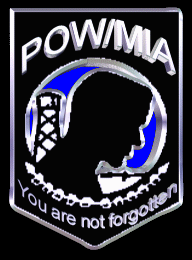
RECOMMENDED WEB SITES RELATING TO THE POW/MIA ISSUE
![]() The Library of Congress - POW/MIA Databases and Documents - Search Page
The Library of Congress - POW/MIA Databases and Documents - Search Page
![]() Central Intelligence Agency (CIA) - Freedom of Information Act - Reading
Room
Central Intelligence Agency (CIA) - Freedom of Information Act - Reading
Room
![]() Texas Tech University - The Vietnam Center and Sam Johnson Vietnam Archive
Texas Tech University - The Vietnam Center and Sam Johnson Vietnam Archive
![]() U.S. Department of Defense - Defense POW/MIA Accounting Agency
U.S. Department of Defense - Defense POW/MIA Accounting Agency
![]() North Vietnam's Prison Camps - Historical Information
North Vietnam's Prison Camps - Historical Information
![]() Scope Systems Database - Allows You To Search For Servicemen Missing By
Date
Scope Systems Database - Allows You To Search For Servicemen Missing By
Date
![]() A Good Summary Of Publications Currently Available on the POW/MIA Issue
A Good Summary Of Publications Currently Available on the POW/MIA Issue
![]()
My Sources :
Information on this site was compiled from the following sources: The P.O.W. Network (Homecoming II Project) , unclassified and declassified documents from U.S. Government agency sources, correspondence/interviews with Kelly's family members and friends, military acquaintances, and other published sources.
The
"MOSCOW BOUND? - LCDR James Kelly Patterson, USN" Web Site
is
owned and maintained by William Newman.
Do
not copy, duplicate, link, or reproduce any portion of this site without
the
owner's expressed written permission.
Copyright © 1998 - 2024 - All Rights Reserved

This
Page Was Created - 19 FEB 1998
Last Updated - 18 DEC 2024